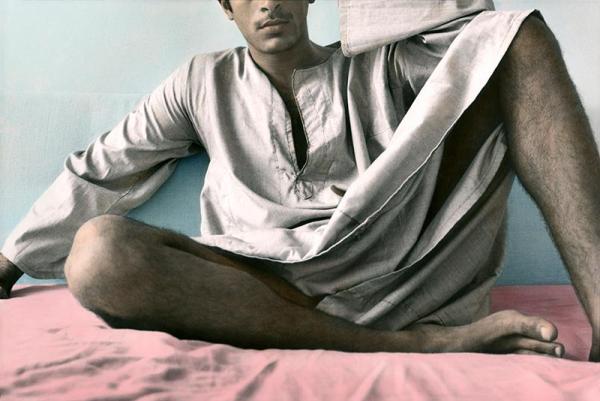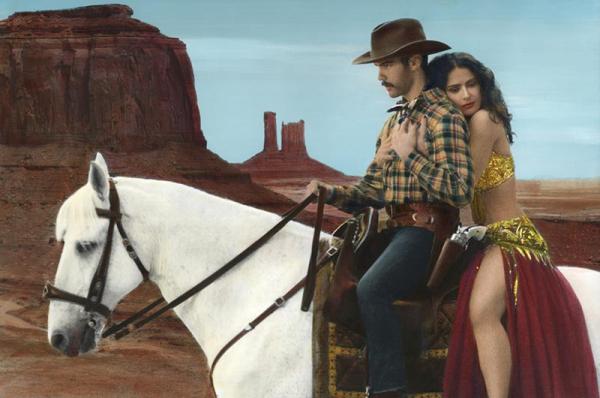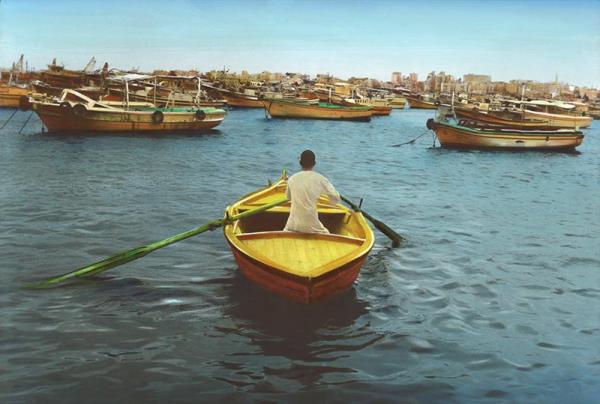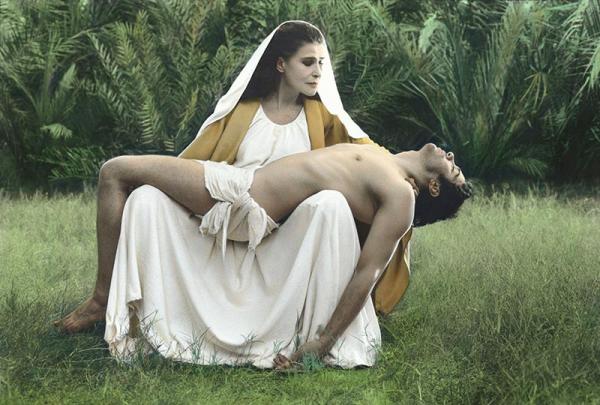As part of a series of monographic exhibitions dedicated to contemporary artists, Palazzo Grassi presents Once Upon a Dream, an opportunity to discover the art of Youssef Nabil through more than 120 works created by the artist during his career.
Photographs, paintings, videos, installations: these the means of expression employed by Youssef Nabil, born in Cairo in 1972 and now living and working in Paris and New York; all different but all part of a tale marked by vaguely nostalgic tones and a dreamlike, legendary character.
Nabil started working as a photographer in 1992, but his imagery began to form well before,  when as a child he was fascinated by the film posters exhibited in the streets of his hometown. These posters introduced Nabil to a traditional technique that would become his distinctive feature: his photographs are printed with silver gelatin and are subsequently hand-painted by the artist.
when as a child he was fascinated by the film posters exhibited in the streets of his hometown. These posters introduced Nabil to a traditional technique that would become his distinctive feature: his photographs are printed with silver gelatin and are subsequently hand-painted by the artist.
When adding colour to the photographs, Youssef Nabil erases the imperfections of reality and transports the characters he immortalises into a timeless reality, in a space suspended between sleep and wakefulness that takes on  symbolic and universal meanings. “Nabil’s use of colour is a way of preventing disappearance,” writes Matthieu Humery, one of the two curators of the exhibition at Palazzo Grassi, in the catalogue accompanying the exhibition. “The bright colours smooth the surface and give the faces a delicate timelessness, transforming them into mental images, into indelible memories .
symbolic and universal meanings. “Nabil’s use of colour is a way of preventing disappearance,” writes Matthieu Humery, one of the two curators of the exhibition at Palazzo Grassi, in the catalogue accompanying the exhibition. “The bright colours smooth the surface and give the faces a delicate timelessness, transforming them into mental images, into indelible memories .
Each work by Nabil tells us about his life: "It is his flesh and his soul,” writes Once Upon a Dream’s co-curator Jean-Jacques Aillagon in the catalogue. Among the constant themes in Youssef Nabil’s works are absence, exile, departure and longing for a lost paradise, since the artist had to leave his homeland, Egypt, guided by the need to feel free and to develop his art outside the country.
Among the self-evident autobiographical works is a powerful series of self-portraits in which Nabil portrays himself from behind in traditional Egyptian clothes within different international settings: he walks away from the observer towards the sea; he lies asleep in front of Botticelli’s Primavera; he walk towards some palm trees in Hawaii.  “The backgrounds change but the artist remains the same, alone and detached from his surroundings. Unlike the artist who portrays himself in various forms, as Courbet did in his many self-portraits, the figure of Nabil, a self-styled exile, is immutable,” writes Linda Komaroff, curator of Islamic art and departmental head of art of the Middle East at the Los Angeles County Museum of Art.
“The backgrounds change but the artist remains the same, alone and detached from his surroundings. Unlike the artist who portrays himself in various forms, as Courbet did in his many self-portraits, the figure of Nabil, a self-styled exile, is immutable,” writes Linda Komaroff, curator of Islamic art and departmental head of art of the Middle East at the Los Angeles County Museum of Art.
The works of Youssef Nabil, however, do not have a single meaning, but overlap different levels of reading; they depict a legendary Egypt that is fading away and, passing through the individual and arriving in the universal, they evoke the critical issues that the Middle East is experiencing at the moment.
at the moment.
Photographs are not the only means of expression of Youssef Nabil: through his videos You Never Left and I Saved My Belly Dancer creates symbolic works of great expressive power. Here too, the intensity and supernatural hues of the colours used, combined with the use of undefined settings, catapult the observer into a mysterious dream.
Once Upon a Dream traces the entire career of Youssef Nabil, focusing both on the oneiric character present in his entire work, and on the narrative aspect of the  exhibition; like in a personal diary, we retrace the stages of the Egyptian artist’s work. However, the exhibition is not a simple monograph, the state of the art of what he has accomplished thus far: Nabil is also the protagonist who through his works reveals his aspirations and his involvement in the 21st-century world of art.
exhibition; like in a personal diary, we retrace the stages of the Egyptian artist’s work. However, the exhibition is not a simple monograph, the state of the art of what he has accomplished thus far: Nabil is also the protagonist who through his works reveals his aspirations and his involvement in the 21st-century world of art.
BOX
Youssef Nabil. Once Upon a Dream
Curated by / a cura di Jean-Jacques Aillagon
and / e Matthieu Humery
Until / fino al 10.01.21
Palazzo Grassi, Campo San Samuele 3231
Due to the current situation, please check the website for any updates on opening days and hours / A causa della situazione odierna, si prega di verificare giorni e orari di apertura sul sito del museo.
www.palazzograssi.it
